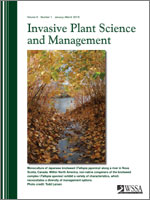Invasive species with distributions that encompass much of the North American environment often demand a range of management approaches, for several key reasons. Firstly, the North American environment includes a large number of highly variable habitats in terms of climatic, edaphic, and landscape features. Secondly, these regional habitat differences are accentuated by jurisdictions within Canada and the United States, whereby approaches and available resources differ at local, regional, and national scales. Another important consideration is whether an invasive species or complex also possesses genetic variation. All three of these factors render the knotweed complex in North America a highly variable target for management. In this paper we review existing knowledge of the variable nature of knotweed species (Fallopia japonica (Houtt.) Ronse Decr., Fallopia sachalinensis (F. Schmidt ex Maxim) Ronse Decr., and Fallopia × bohemica, (Chrtek and Chrtková) J. P. Bailey in North America, and evaluate how herbicidal, mechanical and biological control measures must account for this genetic variation, as well as accounting for regional differences and the potential northward expansion of knotweed under climate change. The imminent release of the psyllid, Aphalara itadori Shinji as a biological control agent in North America must also navigate regional and genetic differences. Prior European experience dealing with the three knotweed species should prove useful, but additional research is needed to meet the emerging challenge posed by F. × bohemica in North America, including the possibility of glyphosate resistance. Managers also face challenges associated with posttreatment restoration measures. Furthermore, disparities in resources available to address knotweed management across the continent need to be addressed to contain the rapid spread of this highly persistent and adaptable species. Linking practitioners dealing with knotweed “on the ground” with academic research is a crucial step in the process of marshalling all available resources to reduce the rapidly spreading populations of knotweed.
Nomenclature: Aminopyralid; glyphosate; imazapyr; Aphalara itadori Shinji; Bohemian knotweed, Fallopia × bohemica, (Chrtek and Chrtková) J. P. Bailey; Japanese knotweed, Fallopia japonica (Houtt.) Ronse Decr. (syn. Polygonum cuspidatum Sieb. & Zucc.); Sakhalin or giant knotweed, Fallopia sachalinensis (F. Schmidt ex Maxim) Ronse Descr.





